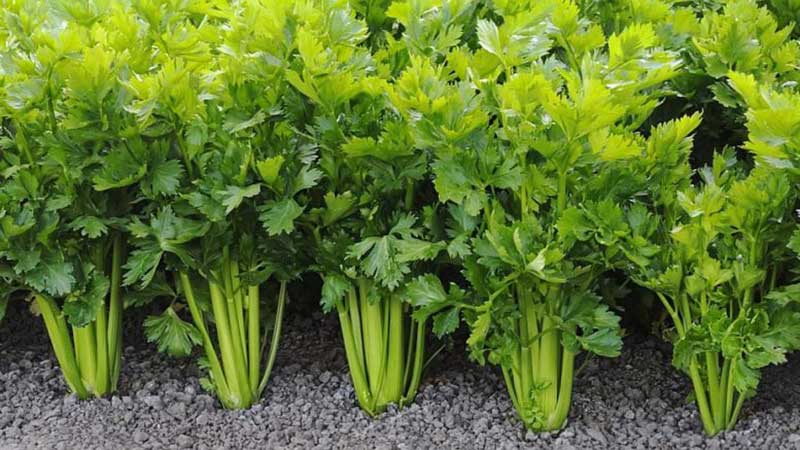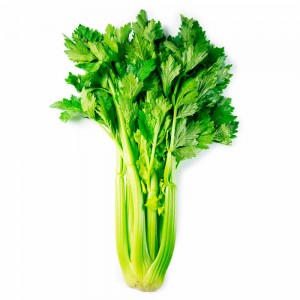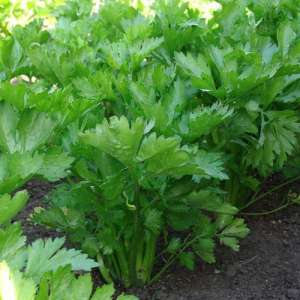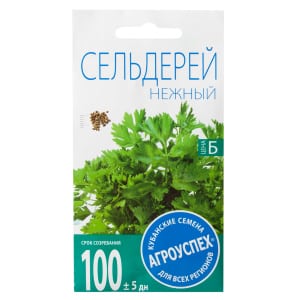Growing leaf celery and caring for it in open ground from planting to harvesting
Among the spicy and healthy herbs grown in our beds, leaf celery takes pride of place. Its delicate shiny leaves are not only tasty and aromatic, they are also a real green pharmacy. It is difficult to list all the beneficial properties of celery, but they are worth finding a place for this crop in the garden. The plant is also universal in use: it is added to various hot dishes, salads and used as a seasoning. Although growing leaf celery through seedlings requires time and effort, it will pay off in full.
What is leaf celery and what are its features?
Leaf celery is a herbaceous plant of the Apiaceae family. Leaf is the most unpretentious among all types of celery, as it is able to grow in various conditions.
Among the main features of this crop are small, bright green leaves and a distinct spicy aroma, which is why the greens are used to create seasonings. Leaf celery does not have a developed root and fleshy petioles, but ripens faster.
The plant is characterized by high productivity - the leaves are cut several times during the season.
Interesting! In Ancient Greece, celery was highly valued. He was depicted on coins, on holidays temples and houses were decorated with plants, and heroes were given woven wreaths of leaves.

Advantages and disadvantages
Experienced summer residents note the following benefits of leaf celery:
- the plant is unpretentious, unlike root and petiole varieties;
- the crop tolerates short frosts relatively easily;
- celery gives high germination (loss of planting material is minimal);
- high yield even in soil of average fertility (greens rarely grow weak, they are almost always juicy and of high quality, suitable for food).
Among the disadvantages, it can be noted that this crop has to be grown in seedlings, so inexperienced gardeners need to learn how to properly prepare seeds, containers and soil. Plants are also often affected by diseases and attacked by pests.
The best varieties for growing in open ground
Celery varieties differ in ripening time, yield and taste. Many gardeners prefer leaf varieties:
- Athena. Greens ripen in an average time - the leaves are cut off 78 days after emergence. The foliage is bright green and medium in size. The variety has high taste and aromatic qualities. From 1 sq. m harvest 1.8-2.1 kg of crop.
- Sail. Mid-season variety. Technical ripeness occurs at 72-80 days. The leaves are green, collected in rosettes. The plant is valued for its excellent taste and high yield - up to 4.7 kg per 1 sq. m. Greens are stored for a long time.

- Oddball. Mid-season celery. The harvest is harvested 100 days after germination. The rosette contains corrugated leaves on thin petioles. One bush weighs up to 120 g. From 1 sq. m cut 2.5 kg of greenery.
- Zakhar. The plant is mid-late. Greens are cut 150-160 days after germination. Celery is consumed fresh and used for any type of processing. The foliage has heavily dissected edges. The size of the sockets is average.The taste and aroma are excellent. This leaf celery is in great demand among gardeners.
- Openwork. Greens ripen early. Large dark green leaves are cut off 75-80 days after germination. One plant weighs about 85 g. Per 1 sq. m grows up to 3 kg of crop. After cutting, new leaves grow quickly.
- Samurai. Early high-yielding variety. The harvest is harvested after 75 days. From 1 sq. m cut up to 4 kg of greenery. The culture is resistant to low temperatures and water deficiency.
- Kartuli. Early Georgian variety. The first leaves are cut off 65 days after germination. The culture grows normally with a lack of heat and moisture.
Don't ignore the new varieties that often appear in gardening stores. Selection is carried out continuously, since the demand for celery is very high.
Timing of sowing and replanting in the ground
Leaf celery is characterized by relatively slow growth, and it is almost impossible to obtain vigorous shoots, so the crop is grown mainly by seedlings.
At home, sowing is done in early March, and in the first ten days of May the plants are transferred to a permanent place.
This is interesting:
The best varieties of dill for greens without umbrellas for growing in greenhouses.
When is it time to collect carrot seeds and how to do it correctly.
How to grow seedlings
Growing leaf celery is practically no different from cultivating other varieties of this plant, although some gardeners note that it is the easiest to grow.
Preparation
Seedlings are grown in various containers, for example:
- plastic containers;
- wooden or plastic boxes;
- cut lengthwise from milk or juice boxes.
Containers must have drainage holes to drain excess water.
High-quality soil is one of the important conditions for proper cultivation of seedlings. Leaf celery seeds are germinated in a substrate that consists of equal parts of humus and turf soil, and one-fifth of sand is also added to the mixture. Next, the finished soil is disinfected with a 1% solution of potassium permanganate and well loosened for better air permeability. Celery does not grow well in acidic soils, so lime is added to such soil (0.3-0.5 kg of the substance is used per 1 sq. m) and lightly mixed with the soil.
Seeds of leaf celery are disinfected for 30 minutes in a weak solution of potassium permanganate, then soaked for 3-4 hours in a growth stimulant, for example, "Epine", and finally kept in water at room temperature for 24 hours.
To moisturize, it is not necessary to completely immerse the seeds in water; you can simply wrap them in a damp cloth and keep them that way for 24 hours.
Important! To prevent excessive moisture from causing rot, do not keep the seeds in a humid environment for more than the specified time. Remove as soon as the grains swell.
Landing
Sowing seeds in containers is carried out according to a 2x2 cm pattern. The planting material is not deeply buried, it is simply laid out on the surface of the soil and lightly pressed with your fingers. Sprinkle a small layer of substrate on top. Next, the container with the seeds is covered with transparent glass or film to create a greenhouse effect.
Seedlings are kept at a temperature of +20…+24°C. Shoots appear after 10-14 days, and then the temperature is reduced to +15...+16°C.
Seedling care
After emergence, the shelter is left for another two weeks until 2-3 leaves appear, but the seedlings are periodically ventilated to prevent mold from appearing. Having removed the film, the grown seedlings are planted in separate containers or transplanted into a large container at a distance of at least 5 cm from each other. Such actions will strengthen the young plants.
The culture needs lighting for 10-12 hours, so additional lamps (preferably diffused light) are installed. The room temperature is maintained at +16…+18°C. Water the crop moderately using a sprayer. The regularity of moistening is once every two days or as the top layer of soil dries.
Fertilize the seedlings 14 days before the intended planting of the plants in a permanent place. For this purpose, mineral fertilizers are used: 5-10 g of superphosphate and 10-15 g of ammonium nitrate are diluted in 5 liters of water.
Important! Fertilizer is applied under the celery root to prevent fertilizer from getting on the tender leaves and stems of young plants. Otherwise, the crop will get burned or stop growing.
Transplantation into open ground
It is better to plant seedlings at a distance of 15-20 cm between plants, and about 30 cm between rows. If desired, celery can be planted between rows of potatoes, garlic or onions.
A handful of wood ash and humus is poured into the planting holes, while fertilizers are mixed with the soil. Plants are deepened to the cotyledonous knee. Next, the soil around the seedlings is compacted and watered. During the first few days, protect the celery from direct sunlight with sheets of paper.
Further care

Celery roots are short, so they take up moisture that is on the surface of the soil. The soil is moistened moderately so that puddles do not form, as they will block the access of oxygen to the roots, wash the soil, exposing the root system, and can lead to rotting.
Celery is watered when the weather is calm, in the morning or evening. The crop should not be moistened at noon or in strong sunshine. For watering, use a spray bottle, drip irrigation or special sprinklers.
15 days after transplanting to a permanent place, the plants are fed with complex fertilizers, which include sodium, phosphorus and potassium. Thus, celery receives the full range of necessary mineral components for growth and development.
The rows are weeded to get rid of weeds and open oxygen access to the roots. Leaf celery is a fragile plant that has a small root system.
Some gardeners mulch a bed of celery to control weeds. For this, sawdust, leaves or agrofibre are used. Mulch reduces the number of waterings.
Did you know? Celery was considered a plant that brought happiness, and it was hung in rooms along with onions and garlic.
Possible problems, diseases and pests
To protect celery and prevent the leaves from bending towards the ground, the plants are wrapped in foil or paper. This is especially useful for varieties with lush and dense foliage. The winding helps the crop to grow vertically without falling apart. Before cutting the greenery, 1-2 days before, remove the wrapper. If celery grows without a protective wrap, the leaves should be trimmed regularly.
Celery is often attacked by pests and affected by diseases that can destroy the entire crop.. The most common diseases and pests and methods of combating them:

- Carrot fly. The winged insect lays eggs on plants in the spring, then the larvae eat celery leaves. For prevention, timely weeding, fertilizing and loosening are carried out.Garlic is planted next to the crop. The pungent odor repels the pest. They fight the fly with a mustard-tobacco mixture, which is sprinkled between the rows of plants. Tobacco dust and dry mustard are mixed in equal parts. For 1 sq. m use a tablespoon of the product. The procedure is carried out every week.
- Carrot leaf flea beetle. The insect flies from coniferous trees and drinks juice from celery leaves. The pest gradually destroys the plant - it becomes deformed and withers. You fight a flea like a carrot fly.
- Bean aphid. The largest pest of its kind. In a week, an entire generation develops. Aphids are destroyed by spraying greenery with a decoction of potato, tomato or dandelion tops.
- Celery (borscht) fly. The insect appears at the end of May and often flies from the hogweed. The pest lays eggs under the skin of leaves. Soon small lumpy spots appear on the greenery - larvae develop there. When they grow up, they begin to eat leaves, leaving tunnels in them. For prevention, they follow the rules of crop rotation, lime acidic soils, thin out seedlings, and plant onions or garlic next to the plants. The hogweed plantation is also being destroyed—mostly the borscht fly comes from there.
- Powdery mildew. The disease manifests itself as a white or gray coating on plants. At high humidity the disease intensifies. Powdery mildew is eliminated by spraying the plantings with thistle infusion - 0.6 kg per 10 liters. The product is infused for 8 hours.
- Rust. Celery becomes covered with red-brown powdery spots. The disease is treated by spraying the plantings with the drug "Fitosporin-M".
Features of cultivation
Leaf celery is a cold-resistant plant.The crop even tolerates return frosts, so greens are grown in the vast majority of regions of the country.
The growing season of leaf celery lasts a long time, so the crop is grown through seedlings so that by the time they are planted in open ground, the young plants have time to get stronger.
Collection, storage and use of crops
Leaf celery is cut several times per season. The first stage is carried out 14 days after planting the seedlings in a permanent place. Greens are cut when they reach a length of 30-40 cm, at a height of 5-7 cm from the ground.
After harvesting, celery is stored in several ways:
- salted;
- frozen;
- dried;
- in the refrigerator without freezing.
The plant is actively used in cooking; it finds its place in a wide variety of dishes. Chopped celery is added to soups a few minutes before cooking to add flavor and beauty. There are many recipes for salads with this herb; it is added to omelettes and even to baked goods and desserts.
For your information. Hippocrates considered celery a cure for all diseases.
Reviews from summer residents
Leaf celery is grown by many gardeners for its beneficial properties and aroma. Reviews from some summer residents are below.
Ekaterina, Odintsovo: «We tried to plant leaf celery for the first time in 2010. It is easy to care for. This green is very healthy, so my husband, children and I mostly eat it fresh and add it to salads. The leaves have an unusual taste. We also make various seasonings from celery. The whole family likes it. I even make face masks from this plant. Now we grow this crop every year.”
Vladimir, Bryansk: “In our village, many people grow leaf celery.Not all beginners like these greens, but judicious use corrects this shortcoming. I use the leaves in dishes to enhance the taste. Celery is an excellent food for weight loss. It helps to lose extra pounds and has a medicinal effect due to the vitamin content of greens. I like leaf celery; growing and caring for it in open ground does not require much effort. I advise everyone!"
Read also:
Celery for weight loss: how much you can eat per day.
Conclusion
Leaf celery is unpretentious; it grows in almost any soil, withstands cold weather and tolerates moisture deficiency. The only difficulty is growing and planting seedlings; otherwise, caring for the plant requires minimal effort and time.
A lot of vitamins and beneficial properties, several harvests per season and a special aroma make the crop valuable in every sense of the word.